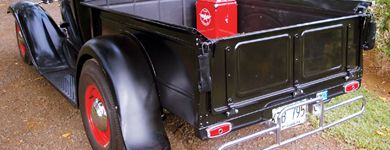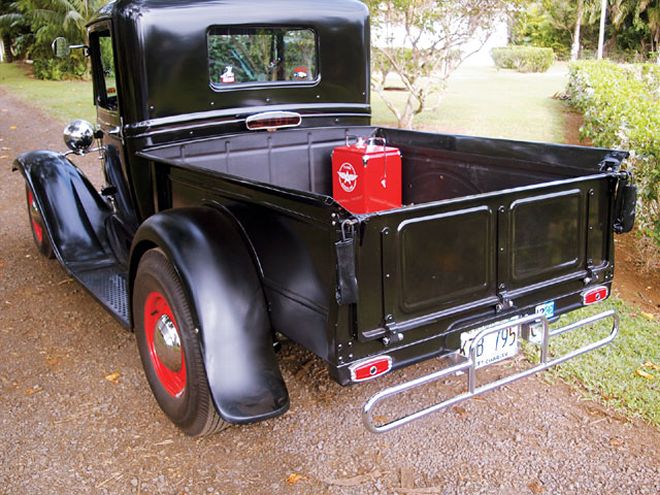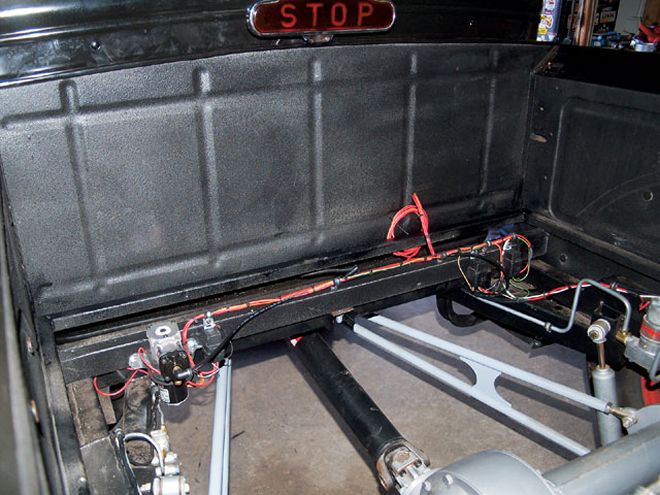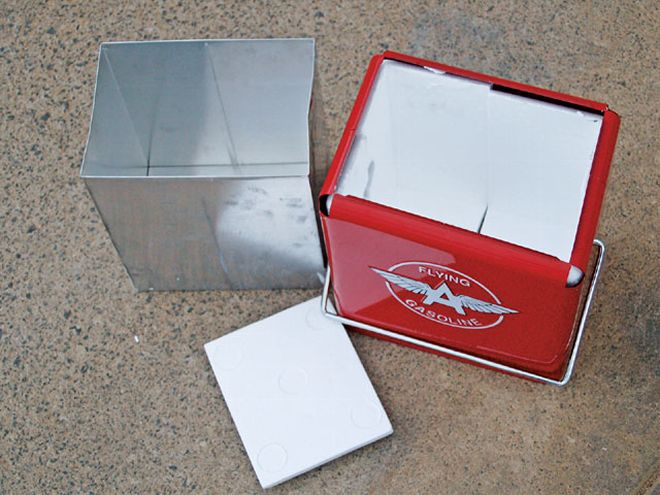
 It's not unusual to run out of space before you run out of parts that need a place when building a street rod. That's why the battery ended up in the bed of our Model A.
It's not unusual to run out of space before you run out of parts that need a place when building a street rod. That's why the battery ended up in the bed of our Model A.
Building a street rod is very similar to putting 10 pounds of stuff in a 5-pound bag; there's often more stuff than there is space to put it. Such was the case when we went to find a place for the battery in our Model A pickup. Under the hood was out of the question due to lack of space, and under the body was out because it was too inconvenient. The only logical spot for the battery was the pickup's bed-there was plenty of room and it would be convenient; we just had to find a way to camouflage it.
It just so happens our very own Road Tour warrior, Jerry Dixey, has a company called Classic Automobilia. Among his wares are pedal cars, trikes, reproduction gas pumps, and other collectibles-including really cool coolers. And it just so happens that a battery will fit inside one.
With a bright red Flying A cooler from Jerry on hand, we went about removing the inner liner and insulation to transform it into a battery box. It was a fairly simple operation; holes for the necessary cables and wires were drilled in the bottom of the box and through the bed floor. To help support the weight of the battery, an aluminum strap was placed across the bottom of the box, so it fits snugly between the floor and the bottom of the box. Two 1/4-20 threaded holes were put into each end of the strap, then a pair of long threaded rods were installed with enough length below the box to secure it to the bed floor and enough above to serve as battery hold-downs. Nuts on the rods inside the box lock them in place.
* Shielding your battery from high-heat sources like headers will greatly extend the life of the battery.
 A number of electrical accessories are under the bed, including the fuel pump, air suspension compressor, and the condenser for the A/C (yet to be installed).
A number of electrical accessories are under the bed, including the fuel pump, air suspension compressor, and the condenser for the A/C (yet to be installed).
Inside the box, mounted to the battery hold-down, we added a fuse for the fuel pump and circuit breakers for the airbag compressor and A/C condenser fan. In addition, we installed a Flaming River combination battery and alternator kill switch. With a conventional two-pole switch, turning it to the off position will not kill the engine-it will continue to run on the alternator even with the battery disconnected. The Flaming River switch will kill a running engine, as it interrupts the alternator circuit as well as disconnecting the battery. This switch meets NHRA and SCCA sanctioning body requirements and has a rated capacity of 2,000-amp surge, 150-amp continuous, and can handle a 120-amp alternator. Of course, the alternator function does not have to be included; we used it as a convenient source to power the fuel pump relay.
The battery we used is a new XS Power Cell from Powermaster. Using AGM (absorbed glass mat) technology, the electrolyte is suspended in an absorbent fiberglass material, eliminating the need to flood the battery with water. This unique design of an AGM enables it to be spill-proof and vibration-resistant while having ultra-low internal resistance. Rattling around in the back of our Model A calls for a rugged battery, and the sealed design alleviates any issues of spilled acid.
The cooler worked great as a battery box for our purposes, but yours doesn't have to be out in the open like ours-one could go in the trunk as well. Either way, your rod's battery can hide in plain sight, too.
 We housed the A's battery in a retro cooler from Jerry Dixey's Classic Automobilia. We removed the inner liner and the insulation to make more room for battery cables and wiring.
We housed the A's battery in a retro cooler from Jerry Dixey's Classic Automobilia. We removed the inner liner and the insulation to make more room for battery cables and wiring.
Proper Care Tips for Powermaster's AGM Battery
* Proper charging is crucial to the life of the battery. Ensure that charge voltage never exceeds 2.5 volts per cell, or 15 volts for a 12-volt battery.
* When using a battery charger, it is best to use a microprocessor-controlled charger like the XS Power Intellicharger. This will ensure the fastest and fullest recharge by allowing the appropriate amperage for the given battery size.
* In deep-cycling applications, it is important to note a battery should not be discharged below 10.5 volts. Doing so may cause damage to the battery.
* Before storing a battery away for the off-season, it is important that it is fully charged. Leaving them for long periods of time in a low state of charge may cause damage to the battery.
* Take special care when handling batteries. They are unusually heavy for their size and sometimes difficult to handle because they are tightly packed with lead. Do not use batteries that have been dropped.
* It is important to pay close attention to the torque specs when tightening the battery terminals to prevent slippage and allow maximum connectivity.